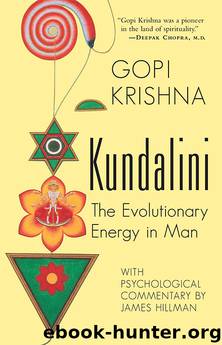Kundalini by Gopi Krishna

Author:Gopi Krishna
Language: eng
Format: epub
Publisher: Penguin Random House LLC (Publisher Services)
Commentary to Chapters Seven, Eight and Nine
In Chapter Seven, the text takes up prana again, this time more metaphysically. In Chapter Eight, we come to another of the traditional problems associated with mystical experiences and that is the question of secrecy. Our author was strongly moved not to tell anyone of what he was going through, not even his wife. Again, this rigid secrecy is typical of one in the throes of a paranoid delusion. To open the secret is in a sense what we call ‘reality testing’. If it were laughed at, argued away, diagnosed as sick, a whole world would collapse. But more, there is something in the nature of mystical experiences that demands secrecy, as if the archetype behind the events which are in process needs a certain tension in order for it to be fulfilled. The alchemists envisioned this secrecy in their image of the closed vessel. In many fairy tales the hero or heroine is ordered not to say anything until the ordeal is over. In the Greek religious mysteries the participants were threatened with death if they told what happened. Initiation rites also require sworn secrecy. Secrecy intensifies, allowing what is coming to fruition to swell and grow in silence so that later it can be brought forth and shown. Secrecy is the ground of revelation, making revelation possible; what happens secretly in the wings, behind the scenes, makes possible the drama when the curtains open and the lights go up. The urge to withhold and keep back is part of being witness to the uncanny. What to hold back, when to tell, whom to tell, how to tell, these questions fraught with peril lie along the razor’s edge between deluded paranoid isolation and individual strength, between arrogant private esotericism and uncertain loneliness of silence. Secrecy, as well, gives individuality; what everybody knows is no longer individual. Without our individual secrets we are only public ciphers.
He tells us in Chapter Eight that ‘at night I found myself looking with dread at horribly disfigured faces and distorted forms bending and twisting into awful shapes . . . . They left me trembling with fear, unable to account for their presence.’ The encounter with distorted human figures in a night-world seems another authentic necessity. It is evidently so important that Homer, Virgil and Dante describe similar phenomena in the descent into Hades of their heroes. It is part of their journey. We find parallels in analysis. After a certain integration has taken place, there sometimes occur dreams of a hospital ward with ill and maimed, or a large photo of all the family members that oppresses the dreamer thereafter for days, or one’s early school class, or club, appear en masse in the analyst’s waiting-room. These shades too need transformation; they are parts that have not been redeemed despite the integration achieved by the conscious personality and its ego. Especially tormented in the Underworld are the unburied dead, those configurations passed away or repressed out of awareness but still not over and done with, hauntingly lingering at the threshold.
Download
This site does not store any files on its server. We only index and link to content provided by other sites. Please contact the content providers to delete copyright contents if any and email us, we'll remove relevant links or contents immediately.
Bodyweight Strength Training by Jay Cardiello(7259)
Tools of Titans by Timothy Ferriss(7079)
Born to Run: by Christopher McDougall(6359)
Inner Engineering: A Yogi's Guide to Joy by Sadhguru(6000)
Asking the Right Questions: A Guide to Critical Thinking by M. Neil Browne & Stuart M. Keeley(4703)
The Fat Loss Plan by Joe Wicks(4310)
Bodyweight Strength Training Anatomy by Bret Contreras(4126)
Yoga Anatomy by Kaminoff Leslie(3765)
Science and Development of Muscle Hypertrophy by Brad Schoenfeld(3642)
Dynamic Alignment Through Imagery by Eric Franklin(3567)
The Four-Pack Revolution by Chael Sonnen & Ryan Parsons(3531)
ACSM's Complete Guide to Fitness & Health by ACSM(3524)
Yoga Anatomy by Leslie Kaminoff & Amy Matthews(3460)
Bodyweight Strength Training: 12 Weeks to Build Muscle and Burn Fat by Jay Cardiello(3432)
The Ultimate Bodybuilding Cookbook by Kendall Lou Schmidt(3396)
Exercise Technique Manual for Resistance Training by National Strength & Conditioning Association(3380)
Nutrition for Sport, Exercise, and Health by Spano Marie & Kruskall Laura & Thomas D. Travis(3298)
Nutrition for Sport, Exercise, and Health by Marie Spano & Laura Kruskall & D. Travis Thomas(3288)
Yoga Therapy by Mark Stephens(3280)
